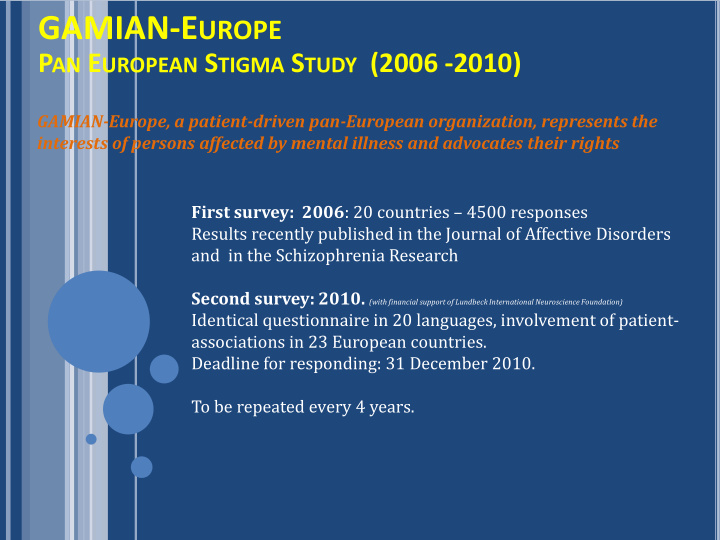



GAMIAN-E UROPE P AN E UROPEAN S TIGMA S TUDY (2006 -2010) GAMIAN-Europe, a patient-driven pan-European organization, represents the interests of persons affected by mental illness and advocates their rights First survey: 2006 : 20 countries – 4500 responses Results recently published in the Journal of Affective Disorders and in the Schizophrenia Research Second survey: 2010. (with financial support of Lundbeck International Neuroscience Foundation) Identical questionnaire in 20 languages, involvement of patient- associations in 23 European countries. Deadline for responding: 31 December 2010. To be repeated every 4 years.
GAMIAN-E UROPE P AN E UROPEAN S TIGMA S TUDY (2006 & 2010) GAMIAN Europe Pan European Survey containing: Demographic questions 16 items Internalised Stigma of Mental Illness (ISMI) – 29 items (Ritscher et al , 2003) Perceived Devaluation and Discrimination Scale 12 items (Link, 1987) Boston University (BU) Empowerment Scale – 17 items (Rogers et al , 1997) 2
GAMIAN-E UROPE P AN E UROPEAN S TIGMA S TUDY (2006 & 2010) Self reporting, supported by the local patient association. Accessible to all patients: No language barrier: everyone can respond in his or her own language Both online and printed version, accessible at the GAMIAN website Possibility to compare 2006-2011 and to detect trends... Possibility to have results country by country, and trends country by country (detect positive or negative effects of local events between 3 2006-2010, possibility of evaluation of local anti stigma campaigns )
GAMIAN-E UROPE P AN E UROPEAN S TIGMA S TUDY (2006 & 2010) Preliminary results based on 500 responses from 10 countries (gathered by Oct 10 th ). Definitive results to be published in April 2011. Analysis of results supervised by Prof. Dr. Marc De Hert (University of Leuven, Belgium) 4
GAMIAN-E UROPE P AN E UROPEAN S TIGMA S TUDY (2006 & 2010) 25% Bipolar disorder 25% Depression 25% Schizophrenia /Schizoaffective disorder 5% Alcohol/Anxiety/Autism/Personality disorder/ OCD /PTSD 20% Unknown / No answer Age: 2006: no data <-> 2010: 75% between 31-59 year 5
GAMIAN-E UROPE P AN E UROPEAN S TIGMA S TUDY (2006 & 2010) Demographic items: most significant trends More respondents are living independently (own house or rented rooms): 2006: 56.4% <-> 2010: 68.8 % Less have a regular income (salary): 2006: 24% <-> 2010: 17% More have knowledge of diagnosis: 2006: 77% <-> 2010: 81.1 % More agree with diagnosis: 2006: 53% <-> 2010: 65% Less in residential treatment: In patient care : 2006 32% <-> 2010 26% Out patient care: 2006 61% <-> 2010 64% 6
GAMIAN-E UROPE P AN E UROPEAN S TIGMA S TUDY (2006 & 2010) Measurement of the levels of stigma that people with a mental illness feel towards themselves, across Europe ( Internalised stigma ); Trends 2006-2010: (% difference) 24% more respondents agree that people with MI make important contributions to society (42 -> 66) 24% more think they can have a good life, despite the MI (34-> 58) 10% more think that living with a MI has made him/her a tough survivor (46 -> 56) 11% more think they are able to live how he/she wants (41 -> 52) 10% more think that people discriminate because of MI (40 -> 50) 7
GAMIAN-E UROPE P AN E UROPEAN S TIGMA S TUDY (2006 & 2010) Measurement of the levels of stigma that people with a mental illness feel towards themselves, across Europe ( Internalised stigma ); Trends 2006-2010: (% difference) 8% more think that people with MI should not get married (22 -> 30) 13% less feel comfortable being seen in public with a person who is obviously MI (58 -> 45) 8
GAMIAN-E UROPE P AN E UROPEAN S TIGMA S TUDY (2006 & 2010) Measurement of the degree to which people with a mental illness believe that the general public hold negative attitudes towards the mentally ill ( Perceived devaluation/discrimination ); No major trends (difference >5%) 4 % more respondents think entering a mental hospital is a personal failure ( 59 -> 63) 4 % more respondents think employers will hire a former mental patient if he or she is qualified for the job ( 47 -> 51) 9
GAMIAN-E UROPE P AN E UROPEAN S TIGMA S TUDY (2006 & 2010) Measurement of the degree to which people with a mental illness believe that the general public hold negative attitudes towards the mentally ill ( Perceived devaluation/discrimination ); 4 % more respondents think that most young women would be reluctant to date a man who has been hospitalised for a serious mental disorder (67 -> 71) 10
GAMIAN-E UROPE P AN E UROPEAN S TIGMA S TUDY (2006 & 2010) Measurement the levels of self-esteem and feelings of power/control that people with a mental illness report ( Empowerment ). 13% more respondents feel powerless most of the time (45 -> 58) 13% more respondents think the misfortunes in their life are due to bad luck (45 -> 58) 8% more respondents have a positive attitude towards themselves ( 61 -> 69) 8% less respondents think that experts are in the best position to decide on what people should do (64 -> 56) 11
GAMIAN-E UROPE P AN E UROPEAN S TIGMA S TUDY (2006 -2010) Conclusions Trends are neither extremely positive nor negative There is still quite a lot to achieve...... Looking forward to the definitive results of the survey in a few months....
Recommend
More recommend